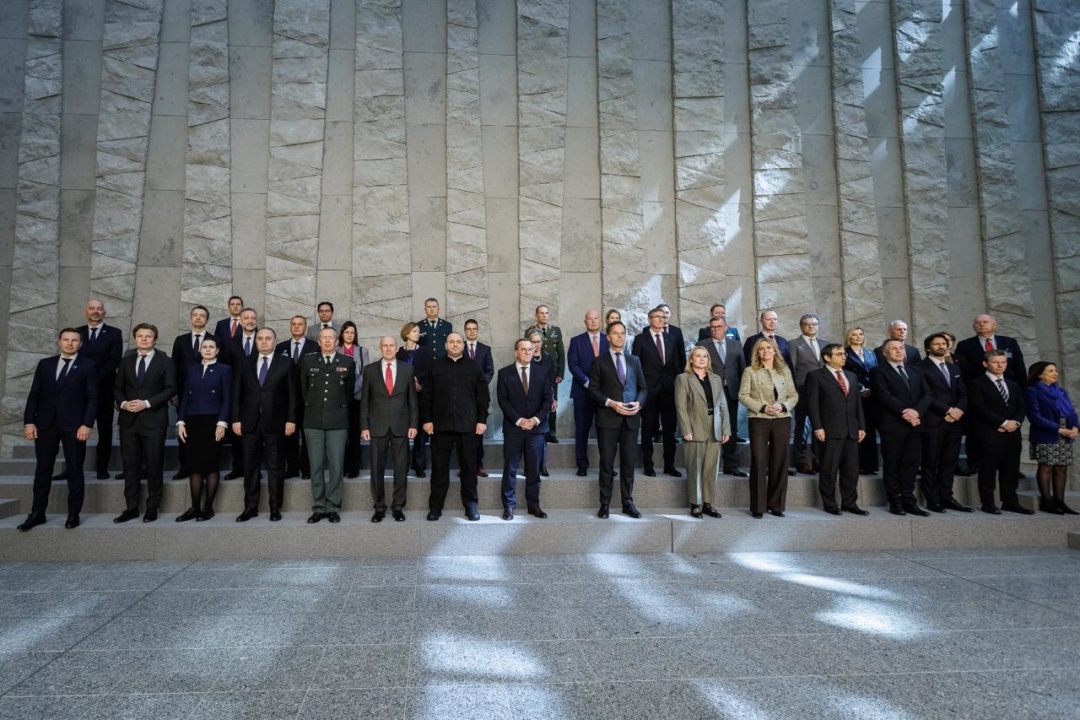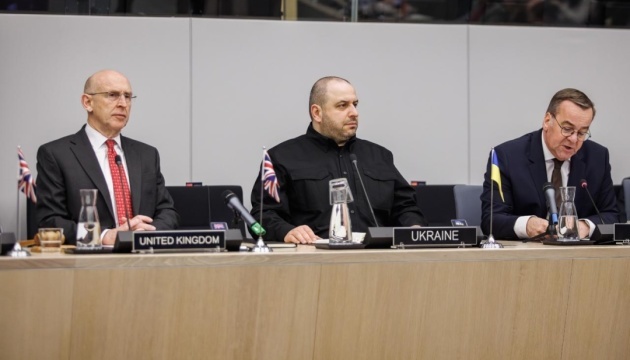Here Ukrinform is summing up the outcomes of the April 11 Ukraine Defense Contact Group meeting of Ukraine’s allies in Brussel
Defense representatives from over 50 member countries of the Ukraine Defense Contact Group, otherwise known as Ramstein Group, met at NATO Headquarters in Brussels for their 27th meeting on April 11 to discuss further aid and support for Ukraine. Co-chaired by the United Kingdom and Germany – indicating Europe’s growing role in Ukraine security — the meeting listened to members of the Ukrainian delegation, led by Defense Minister Rustem Umerov. President Volodymyr Zelensky and US Secretary of Defense Pete Hegseth attended via video conference, while the offline attendance of NATO Secretary General and the top EU diplomat added weight to the gathering.
KEY MESSAGES: UNITY OF EFFORT AND EUROPEAN LEADERSHIP
The year 2025 is “critical” for Ukraine in its fight against Russia’s invasion, UK Defense Secretary John Healey, who chaired the meeting alongside his German counterpart, Defense Minister Boris Pistorius, has said: “2025 is the critical year for the war in Ukraine, and this is the critical moment. A moment for our defense industries to step up, and they are; a moment for our militaries to step up, and they are; a moment for our governments to step up, and they are.”
Opening the meeting, Healey added that “Today, at this Ukraine Contact Group, we step up our support for Ukraine in the fight: ”Our job as defence ministers is to get urgent military aid into the hands of Ukrainian warfighters. All military aid now will help Ukraine in the fight today and help secure a durable peace tomorrow, because the Ukrainian armed forces must be their own strongest deterrent against further Russian attacks”.
Ukrainian Defense Minister Rustem Umerov expressed cautious optimism about future support, noting that 2025 promises to be a record year in terms of the amount of aid provided. He emphasized the need for a comprehensive approach: “There were discussions held on each country, at a bilateral level, and we received support regarding our defense-industrial sector, industrial partnerships, transfer of intellectual property rights, and shared investments. The priorities remain unchanged: air defenses, missiles, artillery, ammunition, and armored vehicles”.
A crucial achievement, according to Umerov, is the progress achieved on the issue of launching the production of air defense systems within Ukraine, although details are not yet disclosed for security reasons.
While acknowledging the consistent role the United States plays as “the key partner for both Ukraine and all of Europe”, the Ukrainian minister noted a shift in Washington’s focus: “After the arrival of the new administration, the US told us that in addition to Europe, in addition to Ukraine, their attention will also be focused on the Asia-Pacific region”. This geopolitical shift objectively places greater responsibility on European allies, which was reflected in the statements Mr Healey and Mr Pistrius made at the meeting.”
UK Defense Secretary John Healy reaffirmed the amount of mobilized resources, announcing new commitments of €21 billion – “a record high increase in funding for Ukraine”. He emphasized his country’s unprecedented contribution of £4.5 billion committed for this year, and pointed to a fundamental change in tactics on the battlefield, where the dominance of drones is becoming a determining factor. “We estimate that 60 to 70 percent of battlefield casualties are caused by drones,” said Healy, emphasizing the urgency of adapting to new realities. The British minister also sharply criticized Russia for its position on peace talks, referring to the Kremlin’s rejection of President Trump’s peace initiative: “Putin said he wanted peace, but he rejected a full ceasefire… he continues to stall and delay negotiations… his troops continue bombardments of Ukraine.” In this context, Healy supported the idea of achieving “peace through strength,” highlighting the need of putting Ukraine in the strongest position for negotiations.
His German counterpart Boris Pistorius too emphasized the special responsibility Europeans will have to bear. He stated that “our goal is and must remain the restoration of peace, freedom and security on the European continent.” Achieving this goal, in his opinion, is impossible without a strong Ukraine capable of defending itself. “It is absolutely clear to me that we therefore still need a militarily strong Ukraine, and it needs our support. Only then can we clear the way for a peaceful solution,” Pistorius stressed, vowing that Berlin’s policy would not change. This position clearly correlates with the statements made by other participants, in particular Dutch Minister of Defense, Ruben Brekelmans, who said, “If we want Ukraine to have a better position at the negotiating table, it is vital to support it on the battlefield.”

Photo Defense representatives from over 50 member countries of Ukraine Defense Contact Group met in Brussels for their 27th meeting to discuss Ukraine’s aid
EU High Representative Kaia Kallas said that the European Union member countries have committed over 23 billion euros in military aid for Ukraine through 2025, well in excess of last year’s level. However, she admitted: “We need to do even more.” Against this background, Kallas noted the complete absence of peaceful signals coming out from Moscow, which, instead, continues to escalate and attack civilians.
ELECTRONIC WARFARE CAPABILITY COALITION FOR UKRAINE: A RESPONSE TO THE DRONE CHALLENGE
German Defense Minister Boris Pistorius announced the creation of a new Electronic Warfare (EW) Capability Coalition to boost Ukraine’s electronic warfare capabilities. With this new coalition, led by Germany, nine such multinational capability coalitions have been established in close coordination with Ukraine and its partners.
“Through this coalition, we want to further strengthen Ukraine’s capabilities in electromagnetic warfare,” said Pistorius.
He explained that the effort would support Ukraine in maintaining communications, gathering intelligence, jamming enemy signals, and countering hostile drones and navigation systems.
Ukrainian Defense Minister Rustem Umerov added that 11 nations have signed a joint letter of intent to join the initiative. The coalition will focus on acquiring equipment, training specialists, and developing electronic warfare doctrines and policies.
“This coalition is designed not only to meet the Ukrainian army’s immediate EW needs, but also to lay the foundation for long-term development,” Umerov said.
The creation of the EW Capability Coalition is not just a formal step, but a strategic response to the evolution of the battlefield. In conditions where drones have become one of the determining factors, as John Healy emphasized, the ability to effectively counter them, protect own communications and control channels, as well as suppress enemy EW systems is assuming critical importance across the battlefield.
As Rustem Umerov noted, “EW is a critically important component of modern warfare.” Without an effective “electronic shield”, modern military units become vulnerable. The creation of a coalition that will take care of the procurement of equipment, training specialists and developing doctrines is a logical response to the technological challenges of war. The ability to “jam” enemy drones, disrupt the enemy’s command and control links, and protect own systems can become that asymmetric trump card that can change the rules of the game on certain stretches of the frontline. The fact that the coalition aims not only to meet current needs, but also to “lay the foundation for the long-term development of these capabilities” indicates the partners’ understanding of the protracted nature of the confrontation and the need to build a sustainable Ukrainian potential.
PARTNERS’ COMMITMENTS
The total amount of new commitments of 21 billion euros, announced by John Healy, is a powerful signal. But no less important are the specific assistance packages announced by the participating countries, which indicate that these commitments are being filled with tangible content.
United Kingdom: On top of the annual commitment of £4.5 billion, London allocates £350 million in funding for immediate needs of frontline troops. This package includes radars, anti-tank mines, “hundreds of thousands of drones” – reflecting recognition of their role – in addition to £150 million in funding to repair and refurbish 3,000 Ukrainian vehicles.
Germany: Pistorius has announced that the German parliament had approved an additional Ukraine support package, bringing over €11 billion in new funding through 2029, on top of previously committed assistance of €7 billion for this year.
These additional funds will be invested in further air defence systems of different ranges and guided missiles, ammunition and spare parts. Among the supplies are four IRIS-T air defense systems, including 300 guided missiles, 300 reconnaissance drones, 120 MANPADS, 25 Marder infantry fighting vehicles, 5 Leopard 1A5 main battle tanks, 14 self-propelled artillery systems, 100 ground surveillance radars, 30 PATRIOT guided missiles, and an additional 100,000 rounds of artillery ammunition.
Germany is also working to establish repair capabilities for military equipment inside Ukraine, planning to sign framework agreements on spare parts and continue its military training missions for Ukrainian troops.
Germany, having already delivered four Patriot systems, cannot provide more from its stockpile, but committed to help find them in other countries and finance the purchase.
The Netherlands: Amsterdam announced the allocation of €150 million to be invested specifically in strengthening Ukrainian air defenses (in cooperation with Britain). This complements the recently announced package of €3.5 billion and the funding of the ongoing projects, including F-16 fighters and drones (€500 million).
Estonia: Tallinn is acting quickly: as soon as this or next week Ukraine will receive 10,000 155-mm shells and 750,000 individual daily food rations. In addition, a fresh package is being compiled to include drones, medical supplies and unmanned systems, formed on the basis of the Ukrainian request. Defense Minister Hanno Pevkur emphasized that “Europe can definitely do more”.
Belgium: Brussels has committed €1 billion in security assistance for Ukraine.
Denmark: Copenhagen has announced its 25th military aid package worth approximately 900 million euros.
Lithuania: Vilnius will allocate additional 20 million euros to purchase ammunition for Ukraine.
End notes:
The 27th “Ramstein” is over. Loud statements were made, impressive amounts of funding were announced, a new capability coalition was launched. A political signal was sent to Moscow – support for Ukraine continues and is even increasing. The concept of “peace through strength” has finally established itself as the prevailing allied strategy. The growing role of Europe in this support is becoming increasingly obvious.
However, behind the scenes of optimistic communiqués remains the harsh reality of a war of attrition. Therefore, the Brussels verdict is twofold. On the one hand, there is a demonstration of unwavering political will and the mobilization of significant resources. On the other hand, the new EW coalition will take time to deploy, and record setting billions of commitments still have to go through a difficult path until they reach forces on the battlefield.
Myroslav Liskovych. Kyiv
Source: Ramstein-27: record setting commitments and electronic warfare capability coalition for Ukraine




